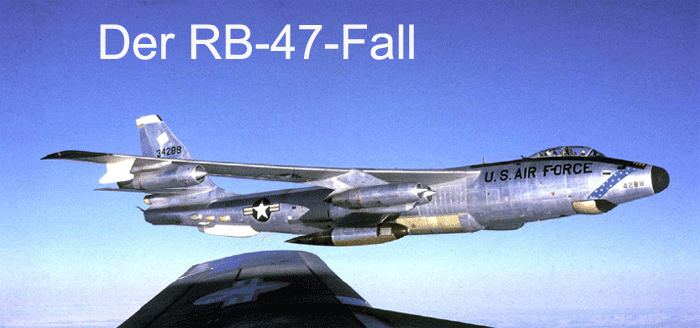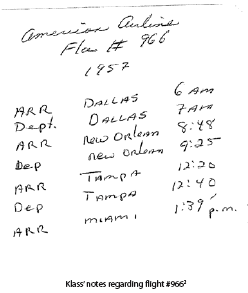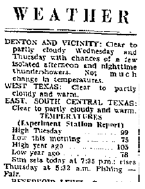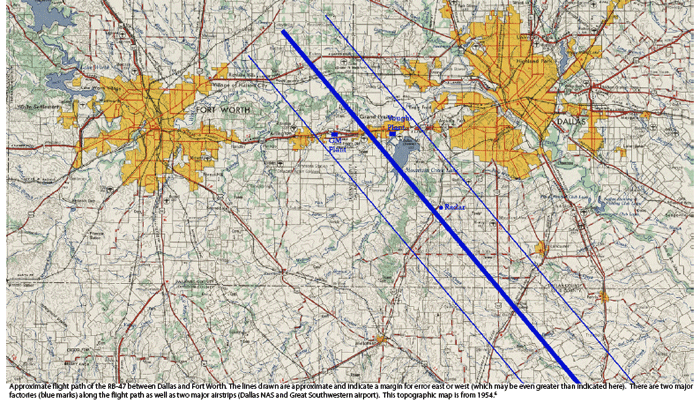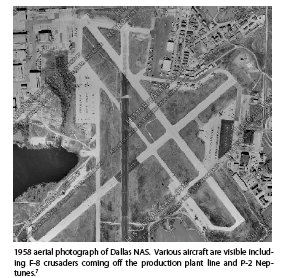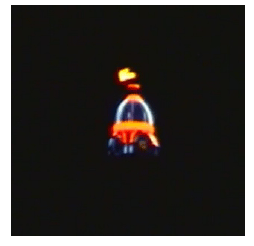Another plane taking off or land7. ing. While Dallas had Love Field, Fort Worth had created its own airport and had called it the Greater Southwestern airport. It is no longer in existence but was to the south of what is now DFW international airport. In 1957, it was fairly active. The RB-47 flight path takes it over this area.
Dallas Naval Air station was also 8. along the RB-47 flight path. Dallas NAS was often used as a way point for aircraft making cross country trips Located at Dallas NAS were two reserve squadrons of P2V Neptunes. The P2V had a large searchlight on the starboard wing tip of the aircraft. Seen from a distance, the searchlight would have been unusual.
The U-2 was mentioned at one point 9. but it seems very unlikely to be the source. The plane would have to have been higher than the RB-47 and possibly reflecting the sun. There were U-2s in southern Texas but they were probably painted black and would not reflect the sun before sunrise when flying at 15,000-30,000 feet .
An unknown man-made aircraft in 19608the area.
So, what was the light? I really don’t know but there are many possibilities. In my opinion, I think it probably was an aircraft of some kind and the P-2V Neptune with it’s searchlight beam is a good candidate to start with. It also might have been just an aircraft landing at or taking off from Great Southwestern airport or Dallas NAS. We really will never know at this point without the actual records of aircraft activity on the date in question.
It is interesting that the handwritten summary stated the CAA had confirmed the aircraft was an airliner (but not flight 966).
Notes and References
Herb, Gert. “A rebuttal to Philip J. Klass’s analy1.
sis of the RB-47 incident of July 17, 1947.” Center
for UFO Studies (CUFOS) Bulletin. CUFOS. Evanston, Ill. Summer 1977. P. 8.
Phil Klass notes concerning the schedule of 2. flight 966. American Philosophical Society. Philip Klass Collection. Box Series II-6.
“Weather”. 3. Denton Record-Chronicle. Denton, Texas. July 17, 1957. P. 1.
McDonald, James. 4. Interview notes with James McCoid. February 2, 1969.
.
RB47 conclusions
.
Is the case solved? I would never suggest so unless there was much more evidence as to aerial activities that morning.
As a result, the case is still “unidentified” so UFOlogists can rest easy on that point. Of course, that is what the definition of a UFO is, right? In this case, the visual was apparently flying and nobody can positively identify it.
Skeptics have no problems accepting the fact the case can not be positively identified. However, it is the proponents that seem to have a problem with a case just having the label of “unidentified”. To have such a label is not good enough. They have to draw conclusions that the evidence does not support.
In the conclusion of his article, Sparks states the case is “irrefutable” and the evidence is “unassailable”. I find such statements hyperbole, which have no place in a scientific endeavour. However, in the following conclusion, one has to wonder what data he is looking at:
This mass of strikingly self-consistent data demonstrates the existence of a large metallic rapidly maneuvering airborne source of S-band radar like signals and visible light - a UFO - that played tag with an Air Force intelligence-gathering jet for more than two hours on the night of July 17, 1957, across four states in the southern United States.1
He states this as if this was proven without a doubt. Objective observers would state that he has not come close to proving this conclusion and that he has rejected other possibilities without good reason.
The greatest UFO case ever?
This case is being billed as the best evidence for UFOs being some form of exotic unknown phenomenon based mostly on what Sparks wrote about the case. This overinflated claim seems to have been simply accepted without questioning it. There are several reasons to question this claim:
We do not know if all the signals reported were the same exact frequency and same characteristics. It is assumed that this is the case but there is no proof this is so. They could just as easily have been in the same frequency range but not the same exact frequency as the signal mentioned in the Piwetz report.
For a majority of the signals, there 2. seems to be radars located along those bearings that might have been detected by the RB-47. Only the signals at time 1030, 1042 and 1044 seem to have questionable radar sources. Since we don’t know exactly what the plane’s heading was at that instant, what the exact frequency of the signals were for those bearings, and what the exact conditions were for radio wave propagation, can we really conclude that these radar signals were emitted by some “unknown airborne intelligence”?
Sparks claims the UFO was large and 3. metallic. However, the witnesses all stated the light/UFO sighted was of small angular size. It never was seen as a physical craft of any kind even when the plane was reasonably close. Is a point source of light really something to get that excited about?
Contrary to what Sparks stated, the 4. UFO sighted never appeared to make any exotic maneuvers. There were statements it paced the aircraft but this is not stated in any of the reports from 1957. There are no indications the visually observed UFO flew loops, stopped on a dime, or zigzagged about. It was just a light that was seen, and when the RB-47 got near the UFO, it disappeared. This makes it nothing more than a nocturnal light, which Dr. Hynek considered to be a waste of time: “We can forget about all this lights-in-the-sky stuff, which we can’t do anything about anyway...”2
There are no UFO reports mentioned 5. by anybody but the crew. One would think a UFO that could be seen from dozens of miles away over a major metropolis like Fort Worth-Dallas, might generate some reports even at that hour of the morning. There were four control towers that were manned in the area (Carswell, Greater Southwestern, Dallas NAS and Love field). Add to this list of potential witnesses were the military personnel on duty at Dallas NAS and Carswell AFB, police officers, early morning commuters, civilian pilots, etc. One wonders why there were no other UFO reports. Additionally, one would expect that some technicians at Duncanville, might go out and see if they could see the RB-47 chasing the UFO as it passed nearby. The lack of any confirming reports indicate the UFO was not as obvious to ground based observers as it was to those in the plane.
It appears that Sparks’ characterization of the “data” and what it proves is just not accurate.
In 1997, UFOlogists presented several of their “best cases” to a panel of scientists. Strangely, the RB-47 case was not one of their primary cases (it was mentioned briefly in the paper about the Condon Study). Is it possible that it has received the label of “the best evidence” because it is now the “flavor of the month”? I can recall reading UFO experts say the same thing about other cases before evidence was unearthed showing they were not as compelling as first thought.
We do know the case was examined to some extent by the Condon study with the conclusion they could not explain it. However, they also realized that it did not mean the case involved some supernatural event/intelligence. Writing in his book, UFOs: An insider’s view of the official quest for evidence, Dr. Roy Craig wrote:
Are we left with only the extraordinary conclusion, or do misinterpretation of observations and vagueness of memory open the door to explanation in terms of the ordinary?3
In my opinion, this latter scenario is more plausible. When faced with choosing between the two scenarios of misinterpretation of events by the witnesses and the presence of some “unknown intelligence” emitting radio waves that acted like a ground radar in use at the time, one will tend to conclude that misinterpretation is more likely.
I doubt that most UFOlogists will side with this type of reasoning. This approach was noted in the Condon study:
....others who desire to have a residue of unexplained cases in order to add mystery and importance to the UFO problem incline to set impossibly high standards of certainty in the evidence before they are willing to accept a simple explanation for a report.4
If only these UFOlogists set equally high standards for evidence that an “unknown intelligence” was involved. In my opinion, the evidence in the RB-47 case is inadequate
to draw this kind of a conclusion.
Lipstick on a pig?
Some might suggest that I have simply “put more lipstick on the same pig” (the pig being Klass’ explanation). I disagree.
My original goal was to evaluate the two arguments presented in the case. In my opinion, I have done this and have determined that nobody has positively established a direct link between the radar signals and the nocturnal light. There seems to be other potential sources for the radar signals and the observed light. All the incidents can be potentially explained and Klass’ argument, while containing some flaws and requiring some tweaking, is still an adequate answer to the RB-47 case.
Notes and References
Sparks, Brad. “RB-47 radar/visual case”. 1. The UFO Encyclopedia: The Phenomenon From The Beginning, Vol. II: L-Z, 2nd Edition. Jerome Clark editor. Detroit, MI: Omnigraphics, Inc.; 1998. Page 790
Close encounter still up in the air for UFO ex2.
pert by Michael Tenszen - Toronto Globe and Mail. July 5, 1982
Craig, Roy. 3. UFOs: An Insider’s View of the Official
Quest for Evidence. Denton: University of North Texas Press, 1995. P. 148
Condon, E. U., et al., eds. 4. Scientific Study of Unidentified Flying Objects. New York: Bantam
1968. p 18
Quelle: SUNlite 1/2012
